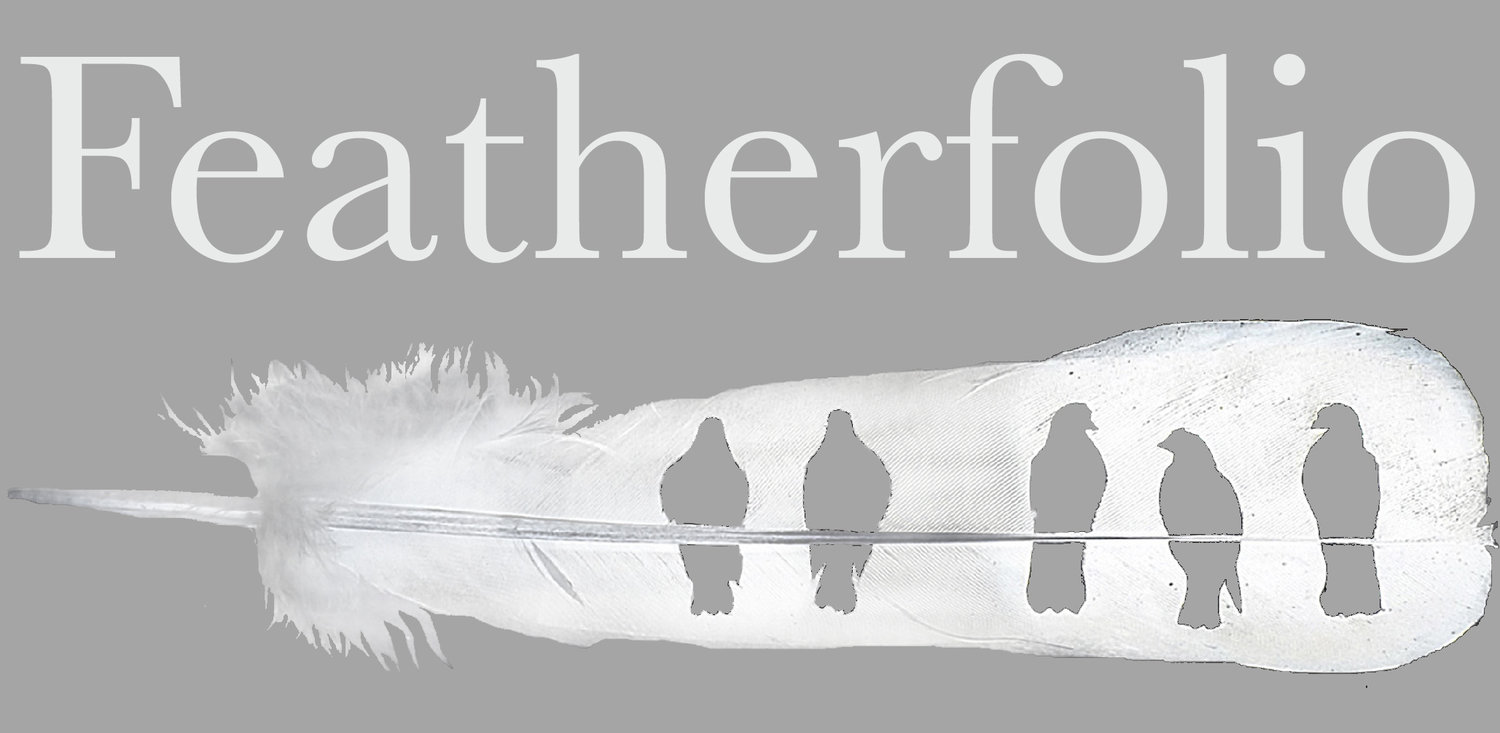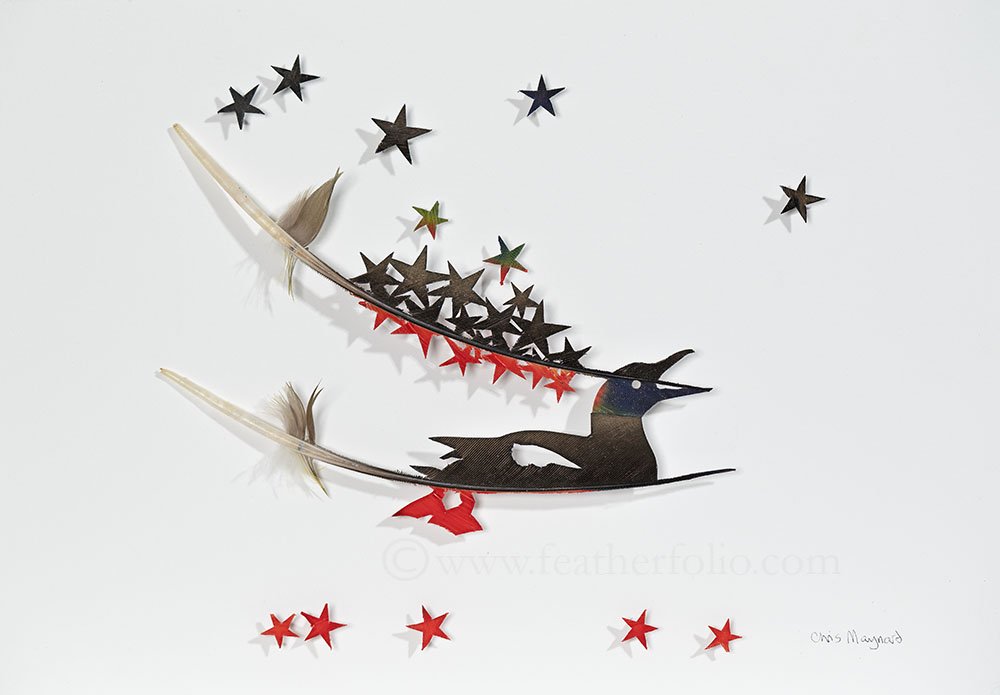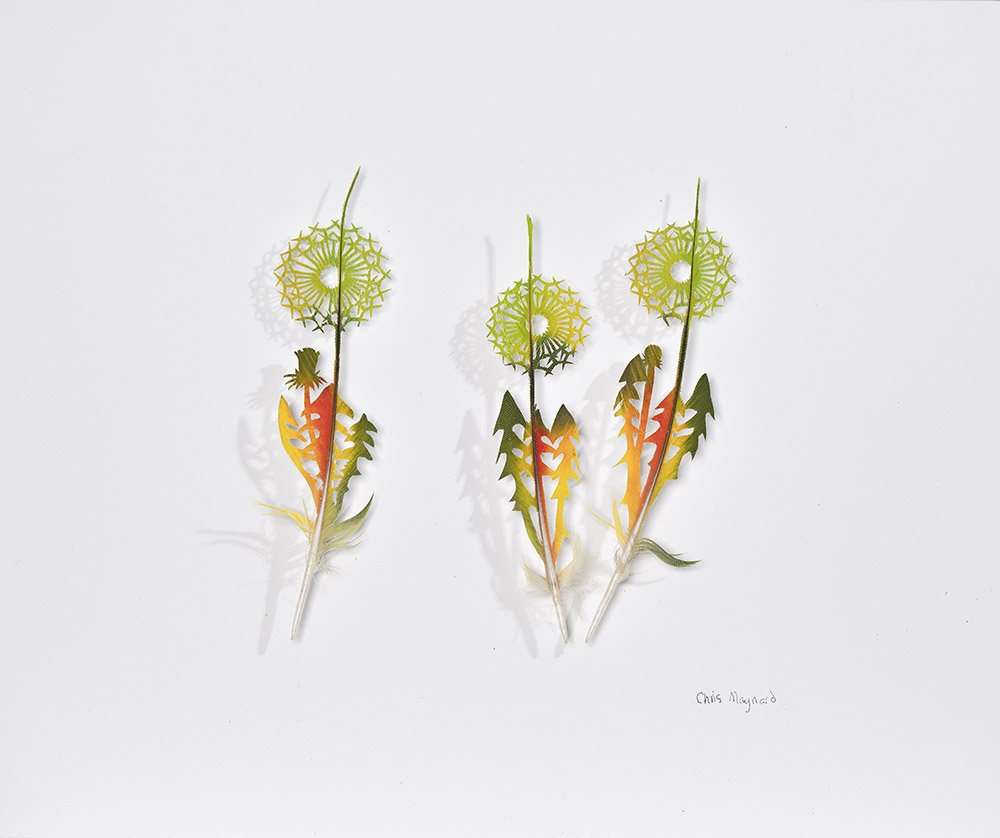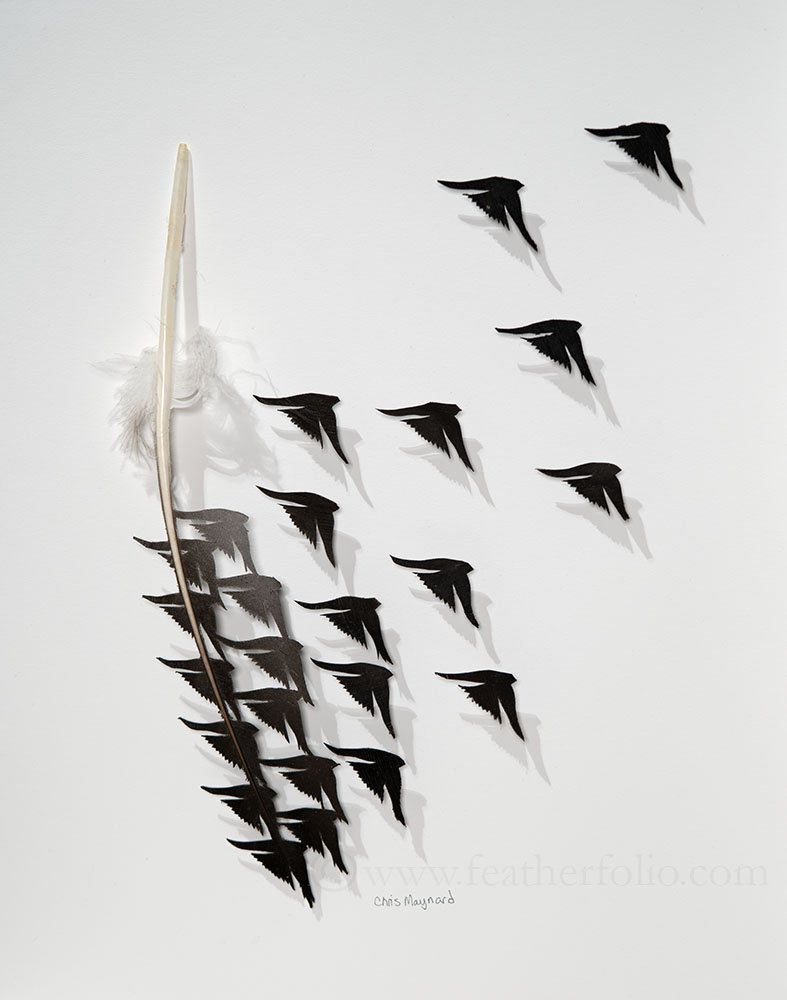In February, The Dewberry, a five star hotel in Charleston, South Carolina served a cocktail that they named after a piece I made that is hanging in their lobby! That is the highest of compliments. We tried it and both the alcohol and the compliment went to my head!
Around and Around /
Kingfisher Pick Up Fish
When I feel bored or rushed, a not too serious part of me says, “Wouldn’t life be simpler if I didn’t have to do repeating everyday chores like brushing teeth or even eating?” I mean, it can sometimes feel like a lot of work. That thought was a genesis for this piece that is one of a small series of birds going around and around with titles like “Pick Up Sticks”.
What if instead of thinking of time as a horizontal line marching along to somewhere, we thought of is as something that repeats, perhaps in a spiral like a breath that goes in and out?
Vashon Show All of April and My Sister /
My sister Robin Maynard’s part of her series, Women Dancing with Vegetables
From April 5th to the 28th, I will have over 20 pieces exhibited at the Vashon Center for the Arts. Vashon is an island a short ferry ride from Seattle. The curator agreed to display a piece of my sisters and one of my mothers, both artists. My sister Robin is a master of color. My mother was also but slowly lost her eyesight when she was older. One of the first to go was color so she painted in black and white, Sumi-e style with charcoal and a brush.
I am limited to using the natural colors in feathers which are mostly browns, blacks, and whites, though I would like to have more color options. Painters have access to unlimited variations of colors. So I can empathize how my mother felt when she lost her eyesight.
Birds of Paradise Feathers? /
Each leaf of the jungled tangles of these Birds of Paradise feathers reminds me of a feather. Maybe that’s why they are named Bird’s of Paradise? Not for the flowers but for the feathery leaves.
Feather Tickler - Another Use for Feathers /
Commercial Feather Tickler for Sensual Play and a Turkey Tail Feather Which Works a Little Better
One of the pleasures of life is, well, pleasure. A light airy touch from a feather awakens the skin’s sensitive nerves. You can do it to yourself, starting with your arm or face. Or better yet, guide another person to “feather” you, like a massage, or a lover as foreplay. A turkey tail feather works best for me, better than the manufactured, dyed commercial “ticklers”. It has something to do with the lite stiffness at the end of the tail feathers and the more direct connection to a real feather.
Migrate /
It is well below freezing here in early January and I am about to travel south to a tropical country for the rest of the month for the warmth. I find myself a bit nervous about the trip even though the airplane does all the work of getting me there in half a day by sunset, places to stay are booked, and restaurants are nearby.
These little songbirds preceded me, taking weeks or months, traveling at night, with the hope that the habitats and foods they are headed toward are still there.
Here is a fascinating moving map of 118 species of songbird migrations on the move during one full year. https://www.allaboutbirds.org/news/mesmerizing-migration-watch-118-bird-species-migrate-across-a-map-of-the-western-hemisphere/
The Tiniest Smallest Feather Carvings /
The Three Little Swallows
These feathers are less than an inch long! This is as small as I can carve using a surgical scalpel.
Most feathers are not this colorful. In fact, most are some form of brown , black, or white. The feathers that do sport color are almost always small and therefore difficult to carve. I usually cut larger feathers. but these small colorful ones keep calling out. Recently I carved/cut small feathers from Lovebirds, Princess Parrots, Asian Jays, and Amazon Parrots to add some color to my works. They are mostly only about 5 by 7 inches as final pieces….which means they cost less but often take almost as much time to create as larger carvings.
Pigeon Guillemots and Their Red Feet /
Close Call study
I wanted to exaggerate these birds’ bright red feet because they are such a striking part of this black-feathered bird.
Like in life, art, and disputes, I find it useful to get different perspectives. It broadens my understanding. But it isn’t always as easy as the changes I made to the drawing of the Pigeon Guillemot. In this piece one sees from the perspective of the fish, the bird’s food. I usually think about this bird and how it goes about its life, wondering what it is like being this feathered creature. But what is life like for this bottom dwelling fish who may at any moment during the day, get snatched up to the surface, crushed in this bird’s beak? And then I wonder what my life would be like if I was stalked by creatures with a fondness for my flesh. I think for one, that I would be much more of aware of my physical surroundings, maybe watch less TV, and spend less time writing blogs.
How to Make a Feather /
This is a wooden child growth feather sold on Etsy
Since most birds shed and regrow feathers year to year, it is helpful to know how to make them. Both feathers and hair are made with the same thing: a protein called keratin. To make a hair, you more or less start by just stacking one protein on top of another within a follicle in the skin.
To make a feather, stack proteins on top of each other in a circle from a the nubbin or follicle inside the bird’s skin.
Route a small blood vessel to each follicle to supply the nourishment to each feather as it grows.
Make sure you cut off the supply when the feather achieves full growth or else the bird could bleed to death if a large feather is pulled out.
Once the feather is grown and blood supply is cut off, the feather is fully functional.
If it should get pulled out, just start the process of making a new feather all over again, immediately. If the feather merely breaks but the shaft remains in the skin, you will have to wait until the year’s next feather pushes the shaft out.
When you get really good at making feathers, please tell me how you get the same pattern and color in each feather every time they shed. And how do you get the same matching feathers on each side of the bird?
No matter how much I read about feather growth, it still seems like a wonderful mystery.
Check out this feather growth animation on YouTube. It was made by Matthew Harris, University of Wisconsin, Madison
Why Starfish Look Like Stars /
My Friend and author Maria Ruth is writing a book about Pigeon Guillemots and diving deep into her subject. She and her crew are doing original research, learning about this bird’s behavior, habits, adaptability, and the sounds they make.
One noticeable thing about these birds is their bright red feet. So I found one of the only larger feathers with red on one side of the shaft and black on the other that could lend themselves to creating these red feet on the black body: the Amazon Parrot secondary wing feathers. I titled this piece, Guillemot Creates Starfish. Just a note: the Guillemot likely did not create starfish by pulling down the stars, that was the direction of my creativity. But I am not ruling it out. Who knows what Maria will next discover about these birds? Look for her book in 2025 from the publisher, The Mountaineers.
A Moth with "Feathers" for Wings. /
Top: the moth genus Alucidae or many feathered moth. Bottom: the genus Pterophorus or white-plumed moth.
A lot of research has focused on how fethers accomplish flight for birds. It would be an interesting school project to learn how these “feathers” help a moth to fly. Some questions I would ask is how do these feather-type wings differ from the flat-wings of most moths in flight? How are these feather-type wings similar and how are they different from bird’s feathers? And how do bird feathers assist flight compared to how these moth “feathers” help the moth fly. Perhaps some background research into how insects and birds use their muscles to fly would be helpful because the larger birds and smaller insects use their muscles very differently to achieve flight.
In science circles it is called convergent evolution when similar things evolve separately in different creatures such as these feather—looking wings on the moths.
Similarities Between Trees and Roots and Feathers and Birds /
Trees as we usually think of them are these big trunks and branches. These are in a way, just the food gathering mouth-parts to serve the roots underground. The roots connect to water, soil, and creatures that break down organic matter and rock so it is available to the roots. Feathers are the same in a way. Each shed feather has a trunk-- the shaft, branches – the barbs, and twigs and branchlets, the barbules. But where are the bird’s roots? The roots of a feather is the bird itself which provides the nutrients for the feather to grow and anchors the feather to its grounding in the bird’s body.
Bird Food /
Goldfinch Food, Amazon Parrot tail feathers, 10 x 12 inches
In a sense, the seeds of the dandelion, when they are eaten by a goldfinch, get reconstituted into the bird’s feathers. My themes always have to do with birds. I find it perfectly acceptable to carve the birds’ food in this piece without carving the bird images themselves. However, I did make two large takeoffs on this with flying goldfinches accompanied by dandelion seeds whisked away in the wind. One is pictured on my website home page.
White Bird Dance Awards /
Portland Oregon is the western US center for dance performance because of the efforts of two men. Paul King and Walter Jaffe created White Bird Dance to promote dance including importing world class dance companies to Portland.
White Bird Dance company asks me yearly to create four carved feather pieces in frames to present to people who are influential in bringing the art of dance into the world.
I was impressed this year at the fall fundraising event when Mikhail Baryshnikov spoke, appreciating the efforts of Paul and Walter. The awards have gone to dance choreographers like Paul Taylor and Twyla Tharp. This year one of the awards went to Virginia Johnson who just retired as the artistic director of the Dance Theater of Harlem.
Article published for Orion Magazine /
Five Million Tonnes of Feathers Wasted! What To Do? /
It surprises me that little is done to use the millions of tonnes of the world’s chicken byproduct—feathers. For fifteen years I have read about optimistic research into how to use feathers in a productive way instead of sending them to landfills. Some farmers use them as low-grade feed but it is usually cheaper for them to just bury the feathers in a landfill. Researches have come up with many other ways to re-use feathers in industial processes but I can’t find any major way they are actually doing it on a big scale.
You can read about investigations into industrially processing feathers to form different kinds of plastics for uses from flowerpots to automobile dashboards. Or just made into plastic biodegradable pellets that can be made into many things. Just search, “industrial feather waste use”.
This truck full of waste feathers tipped over a few years ago on the highway north of where I live.
Stop Motion of a Large Piece /
Feather carving
In the stop motion video, you can see the progression of placement and cuts. For me, what really stands out is how the feathers and the cutout birds pop out at the end when they are elevated. The shadows give the work an added dimension.
A big piece like this usually comes after making several smaller pieces where the design concepts are tested. It took a while to collect enough of the right feathers—these are all from the right side of the wing of molluccan cockatoos. Some were shed from a pet bird over several years and some shed in a nonprofit rehabilitation sanctuary for parrots.
I often show a playful element in my work. Playfulness allows me to learn new things and skills without being too tense, like young swallows just off the nest learning to fly. They often play with an airborne feather (that I provide), catching it in their beaks on the wing, dropping it, and picking it up again and again. I bet they were enjoying improving their flying and bug catching skills.
This large almost five-foot piece will be for sale in Arts Council of Big Sky Montana at their February 2024 event.
Light a Fire /
Phoenix, female Red-tail Black Cockatoo tail feather
Phoenix . female red-tail black cockatoo tail feather
To make a fire, you can use a bunch of dry fluffy feathers as a fire starter. This worked almost as well as paper in my wood stove.
For most people, paper is easier to come by. But for me and say, a chicken farmer, feathers are a ready source. One caution: a lot of down feathers floating around as you strike a match could cause something like a slow explosion. If that happened, you might need to rise from the ashes like a Phoenix.
A Vegetarian Bird /
Singer, Embarrassed Goldfinch
Goldfinches are one of the most vegetarian of birds. They eat seeds mostly, regurgitating them to feed their young, pulling seeds out of thistles, and all sorts of plants. I watch them out my dining room window hanging rightside up and upside down on thin swaying stalks of seed pods of cornflowers. Reading about them, I learned a new name for their vegetarian style of eating: granivores.
This feather carving isn’t yellow! I couldn’t find an appropriate small yellow feather so I just used this one and called the bird embarrassed.
Terres, John K. (1980). The Audubon Society Encyclopedia of North American Birds. New York: Knopf. p. 329. ISBN 978-0-394-46651-4.
Swiftest Flight /
Swiftly, Crowned Crane secondary wing feathers
The swifts are little jet fighters of the bird world. Kayaking down the Cispus River, I gazed at dozens of Vaux Swifts flying above me along the river corridor. That is, when I wasn’t avoiding boulders and white water drops. These bird grow wing bones shaped differently than swallows which they otherwise sort of look like. It makes them look like fast jets and they fly like it. And they fly high and for up to 10 months without landing, drinking, feeding, molting, mating, and probably sleeping on the wing. I read on BBC Science Focus that during a lifetime, they can fly as far as to the moon and back seven times!.
I returned from the river and made this piece. The birds move and turn so quickly, they seem to just disappear all of a sudden, much like the Starship Enterprise when it goes into warp speed.



















